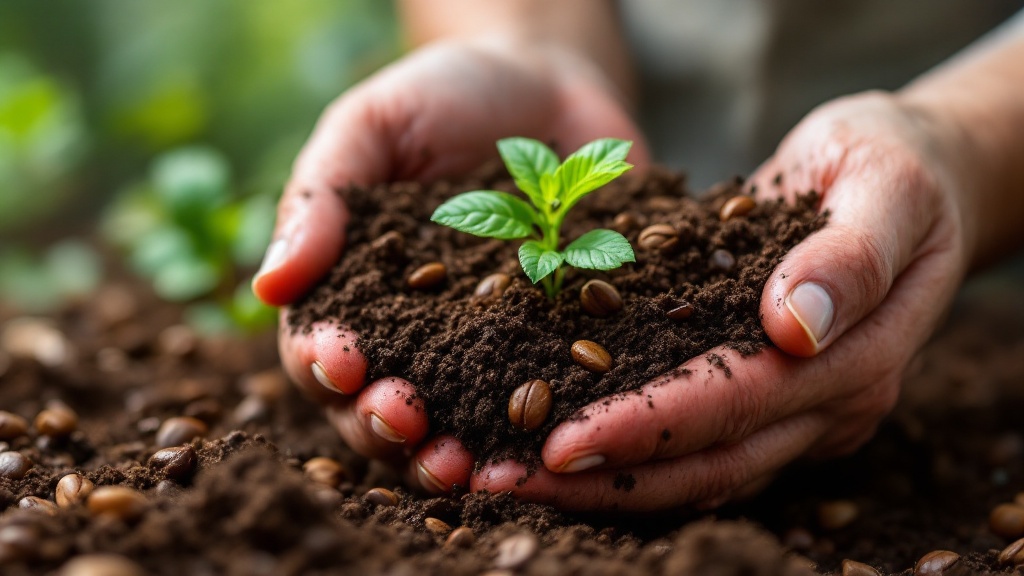Every morning, millions of coffee lovers around the world brew their daily cup. But how many of us consider the environmental impact of that simple ritual? Traditional paper filters, often bleached with chlorine, contribute to deforestation and landfill waste. This is where eco-friendly coffee filters come in, offering a sustainable solution for a guilt-free caffeine fix. Let’s dive into the world of sustainable brewing and explore how you can make a positive impact with every cup.
The Rise of Sustainable Sipping: Why Eco-Friendly Filters Matter

The shift towards eco-consciousness has permeated every aspect of our lives, and coffee brewing is no exception. As awareness of environmental issues grows, so does the demand for sustainable alternatives to traditional coffee filters. The sheer volume of coffee consumed globally amplifies the importance of making eco-friendly choices. Imagine the collective impact if every coffee drinker switched to a sustainable filtering method!
Beyond reducing landfill waste, choosing eco-friendly filters can contribute to preserving forests and reducing water pollution caused by chlorine bleaching. This sustainable choice aligns with a growing movement towards zero-waste living, minimizing our impact on the planet one cup at a time. The best part? Eco-friendly filters don’t compromise on coffee quality – in fact, many argue they enhance it.
Filter Paper Permeability
The performance of any coffee filter, regardless of its material composition (e.g., bleached paper, unbleached paper, metal mesh, reusable cloth), is fundamentally dictated by its permeability. Permeability, expressed as a coefficient (often denoted as K) representing the rate of fluid flow through a porous medium, directly impacts extraction yield and brew quality. A highly permeable filter, like a coarsely woven metal mesh, allows for rapid water passage, resulting in a shorter brew time and a potentially under-extracted cup, characterized by weak flavor and acidity. Conversely, a filter with low permeability, such as a densely woven cloth or a fine-pore paper filter, slows down the water flow, extending the brew time and promoting a more thorough extraction, leading to a richer, more nuanced cup but potentially increasing the risk of over-extraction and bitterness if the grind size or brew time is not carefully managed. The optimal permeability is dependent on various factors including coffee bean grind size, water temperature, and desired brew strength.
- Permeability is measured using various methods, including the Darcy’s Law, which relates flow rate to pressure difference and filter properties.
- Different filter materials have vastly different permeability coefficients (K): metal mesh >> paper > cloth.
- Finer coffee grinds necessitate lower permeability filters to prevent channeling and ensure even extraction.
- Higher water temperatures generally require higher permeability filters to manage faster extraction rates.
- Improperly chosen filter permeability can lead to uneven extraction, resulting in a sour or bitter taste.
- Some pour-over devices are designed to work optimally with specific filter permeability ranges.
| Filter Material | Permeability (K) | Brew Impact | Environmental Impact |
|---|---|---|---|
| Metal Mesh | High | Rapid water flow, shorter brew time | Reusable, reduces waste |
| Paper | Medium | Balanced extraction, moderate brew time | Biodegradable, but may involve bleaching |
| Cloth | Low | Slower water flow, richer extraction | Reusable, eco-friendly |
Exploring the Eco-Friendly Options: A Filter for Every Brewer

The market for eco-friendly coffee filters offers diverse options to suit every brewing style and preference. From reusable metal filters offering a robust, full-bodied brew to compostable paper filters providing convenience with a clear conscience, the choices are plentiful.
Metal Filter Mesh Micrometry
The performance of reusable metal coffee filters is significantly impacted by the micrometry of the mesh. Mesh size, expressed in microns (µm) or threads per inch (TPI), directly correlates to the filter’s permeability and extraction efficiency. Finer meshes, with smaller micron ratings (e.g., 20-40 µm), yield a cleaner cup by more effectively trapping fine coffee particles, resulting in a less sediment-laden brew. However, finer meshes also increase brewing time and may restrict water flow, potentially leading to under-extraction if not accounted for with adjustments to the grind size and brewing parameters. Conversely, coarser meshes (e.g., 80-100 µm or higher TPI) permit faster flow rates and may result in faster brewing, but they sacrifice clarity, allowing more fines to pass through. Optimal mesh size depends on the desired balance between clarity, extraction, and brewing speed, requiring experimentation with different mesh sizes and adjustments to brewing techniques.
- Unbleached Paper Filters:These filters are made from natural, chlorine-free paper, minimizing chemical processing and environmental impact. Their pore size typically ranges from 8-12 microns, effectively filtering coffee grounds while allowing flavorful oils to pass through. Look for filters certified by organizations like the Forest Stewardship Council (FSC) for assurance of responsible forestry practices.
- Reusable Metal Filters:Crafted from durable stainless steel, these filters are a long-term investment that eliminates paper waste entirely. Their mesh design (300-400 microns) allows for a fuller-bodied brew, favored by coffee aficionados like James Hoffmann. Easy to clean and maintain, they are a popular choice for both home brewers and commercial establishments.
- Cloth Filters:Often made from organic cotton or hemp, these filters offer a unique brewing experience. Their pore size varies but effectively traps oils and fine particles, resulting in a clean cup. They require more care than metal filters, needing to be rinsed and dried after each use.
- Bamboo Filters:A rapidly growing renewable resource, bamboo is a highly sustainable material for coffee filters. Biodegradable and compostable, these filters offer similar performance to paper filters but with a much lower environmental footprint.
- Compostable Filters:These single-use filters are designed to break down completely in a compost environment. Ensure they meet ASTM D6400 or EN 13432 standards to guarantee their compostability. Check with your local municipality for composting guidelines and facilities.
- Micron ratings directly influence brewing time; finer meshes (20-40µm) significantly extend brewing compared to coarser meshes (80-100µm).
- The relationship between mesh size and extraction is non-linear; finer meshes may lead to under-extraction if grind size isn’t adjusted.
- Higher TPI (threads per inch) indicates a finer mesh, resulting in better particle retention but potentially slower flow rates.
- Experimentation is key to finding the optimal mesh size for your preferred brewing method and coffee bean characteristics.
- Consider the type of coffee being brewed; robust beans might benefit from a coarser mesh to avoid over-extraction.
- Many metal filter manufacturers provide micron ratings or TPI for their products to aid in selection.
Beyond the Bean: The Future of Coffee Filtration

Innovation in the eco-friendly filter market continues to evolve, pushing the boundaries of sustainability. Researchers and entrepreneurs are exploring novel materials and technologies to further minimize the environmental impact of coffee brewing.
Agricultural waste, like banana fibers and coconut coir, is being transformed into sustainable filter alternatives. Companies like Bananatex are pioneering this approach, diverting agricultural waste from landfills and creating valuable products. Nanotechnology is also being explored to enhance the durability and filtration efficiency of reusable filters. Perhaps the most intriguing innovation is the development of edible coffee filters made from materials like rice paper, eliminating waste entirely.
Nanofiber Filter Media
The application of nanofiber technology presents a significant advancement in coffee filter design, offering potential improvements in filtration efficiency and longevity compared to traditional paper filters. Electrospinning, a widely used technique, is employed to create non-woven mats composed of continuous nanofibers from various biodegradable polymers like polylactic acid (PLA) or polycaprolactone (PCL). These nanofibers possess significantly higher surface area-to-volume ratios than conventional micron-sized fibers found in paper filters. This enhanced surface area facilitates superior adsorption of coffee solids, leading to a cleaner, more refined brew with reduced sediment. Furthermore, the intricate porous structure of the nanofiber mat allows for precise control over pore size distribution, optimizing filtration performance to target specific particle sizes for removal.
- PLA and PCL polymers offer biodegradability, reducing environmental impact compared to traditional paper filters.
- Electrospinning allows for precise control over fiber diameter, impacting pore size and filtration efficiency.
- Higher surface area leads to improved extraction of desirable coffee oils and compounds, enhancing flavor.
- Potential for customized pore sizes to target specific coffee particle sizes for removal, optimizing clarity.
- Nanofiber filters may offer increased durability and reusability, reducing waste.
From Grounds to Garden: Composting Your Coffee Filters

Composting is a crucial aspect of the zero-waste movement, and coffee grounds and filters play a valuable role in enriching compost. Coffee grounds are a rich source of nitrogen, while compostable filters provide carbon, creating a balanced compost mixture. Before adding your filter to the compost bin, make sure it’s certified compostable according to ASTM D6400 or EN 13432 standards. Some filters may also require removal of any plastic components, like the rims of certain brands.
If your municipality offers a composting program, check their guidelines for acceptable materials. Many encourage the composting of food scraps and certified compostable products. Composting not only reduces landfill waste but also creates nutrient-rich soil for your garden, completing the cycle of sustainable living.
ASTM D6400 Compliance
Successful composting of coffee filters hinges critically on their compliance with relevant biodegradation standards. The ASTM D6400 standard, “Standard Specification for Compostable Plastics,” provides a rigorous framework for assessing the ability of a material to decompose in a composting environment. This standard defines specific parameters, including disintegration time, degree of decomposition, and the absence of toxic residues. Manufacturers of compostable coffee filters must adhere to these parameters to achieve certification under ASTM D6400 or the equivalent European standard, EN 13432. These standards specify testing methods to determine whether a product will fully decompose into carbon dioxide, water, biomass, and humus under specific controlled composting conditions. Failure to meet these criteria may result in persistent microplastics in compost and soil, leading to potential environmental contamination.
- D6400 specifies disintegration within a timeframe (e.g., 6 months) under controlled composting conditions.
- Testing measures the remaining mass of the filter to determine the degree of decomposition.
- Compliance requires assessing for the absence of heavy metals or other toxic residues in the compost.
- European equivalent standard EN 13432 shares similar requirements for compostable materials.
- Non-compliant filters can lead to microplastic pollution in soil and waterways.
- Certification demonstrates a commitment to environmentally friendly product design.
Brewing a Better Future: Making the Switch to Eco-Friendly Filters

Choosing eco-friendly coffee filters is a small but significant step towards a more sustainable lifestyle. By making this simple swap, you contribute to reducing deforestation, minimizing landfill waste, and supporting environmentally responsible practices. The global eco-friendly coffee filter market is projected to grow at a CAGR of 6.5% from 2021 to 2028, reflecting a growing consumer demand for sustainable products.
Whether you opt for a reusable metal filter, compostable paper filters, or innovative alternatives like bamboo or banana fiber, your choice makes a difference. So, next time you brew your morning cup, consider the impact of your filter and join the movement towards sustainable sipping. Every cup counts!
Reusable Filter Material Analysis
The efficacy of reusable coffee filters hinges significantly on material selection and its impact on brew quality. Stainless steel, a prevalent choice, exhibits high durability and resistance to corrosion. However, its inherent lack of porosity necessitates a finer mesh size to prevent sediment passage. Mesh size, typically measured in microns, directly influences extraction efficiency. A mesh size of between 150 and 200 microns generally provides a good balance between clarity and extraction of desirable compounds from coffee grounds. Finer meshes, while producing cleaner brews, can impede water flow and result in longer brewing times, potentially over-extracting bitter compounds. Conversely, coarser meshes might allow excessive sediment to pass through, impacting the final cup’s texture and clarity. The manufacturing process of stainless steel filters also impacts sustainability; sourcing from recycled materials is crucial to minimizing the environmental footprint.
- Cloth filters (e.g., cotton, nylon) offer a different porosity profile than metal, impacting extraction and cleanup.
- Electro-polished stainless steel minimizes surface imperfections, improving cleanliness and reducing potential mineral buildup.
- A 150-micron mesh allows for a good balance between extraction and brew clarity in most brewing methods.
- The lifespan of reusable filters varies significantly based on material, cleaning habits, and frequency of use.
- Some manufacturers offer certifications (e.g., food-grade stainless steel) that ensure material safety.
| Filter Type | Mesh Size | Brew Clarity | Sustainability |
|---|---|---|---|
| Stainless Steel | 150-200 microns | Good balance | Recycled materials |
| Cloth (Cotton/Nylon) | Varies | High clarity | Reusable |
| Compostable Paper | N/A | Moderate clarity | Biodegradable |

